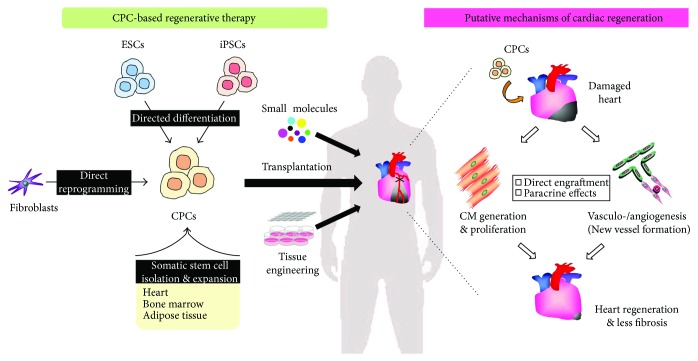Figure 1.
CPC-based regenerative therapy for heart disease. Cardiac progenitor cells (CPCs) can be obtained through several approaches (left). Directed differentiation of pluripotent stem cells such as embryonic stem cells (ESCs) or induced pluripotent stem cells (iPSCs) can generate “developmental (embryonic)” CPCs, while isolation and expansion of tissue- (i.e., heart) resident stem/progenitor cells can generate “adult” CPCs. Recently, an alternative approach by employing direct reprogramming can also generate “inducible” CPCs. These purified and expanded CPCs combined with small molecules and/or tissue engineering can be therapeutically transplanted into the damaged hearts of patients, such as those suffering from ischemic cardiomyopathy. Putative cellular mechanisms of cardiac regeneration by CPC-based therapy (right). Transplanted CPCs can be engrafted directly into the damaged host cardiac tissue and differentiated into mature cardiomyocytes as well as vascular cells (smooth muscle cells and endothelial cells). Simultaneously, the CPCs can potentially promote proliferation of preexisting cardiomyocytes in the damaged heart and also induce vasculo-/angiogenesis in the ischemic regions through secretion of the paracrine factors. Theoretically, increased working cardiomyocytes and newly formed vessels could lead to effective heart regeneration and a reduction in cardiac fibrosis in a coordinated fashion. Further details for cell-free approaches (e.g., small molecules and tissue engineering), somatic stem cell-expansion derived from bone marrow and adipose tissue, and CPC therapy-related mechanisms for cardiac regeneration have been reviewed elsewhere [6, 7].

